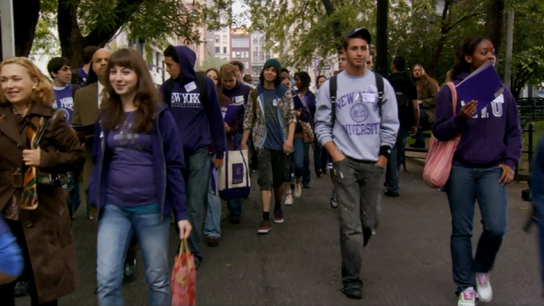Print Edition: August 21, 2012
The Step Up movies might appear to many as unintelligent: a collection of thin stories and body twists that are neither as beautiful as the great dances of proper past musicals nor as economical in their gyrations as a music video. But perhaps most noticeably now in this season of orientations and the maneuverings of hallways and transit, majors and extracurriculars, this common act of dismissal fails to notice the heart of the series, which rests in the setting of school, the coming together of far flung unfamiliars, and the learning of expression.
The first Step Up, a blueprint though it may be, is something of an anomaly taken with the rest of the series. It is the only one to be shot in ‘scope, yet framed in a looser fashion, emphasizing the fact that the dancing is taking place in rooms, studios and backyards, even when their number tries to fill the screen. It is the only one to chart its course toward a single date with end-of-the-school-year destiny, leaving the vast majority of its numbers to be practice, practice, practice. And, it is the only one to see one of its leads go on to continued mainstream success as an actor – Channing Tatum. Step Up is all about charting the realistic beginning of reluctant inspiration, even as it exists in a complete movie-verse. The heavy competition of the subsequent Step Ups is absent but so is the assembling, the coming-together, of differentiated, defined talents on a large scale – here it’s a local love story where differences find unity in combined, remixed art.
That expansion comes in the hands of Jon M. Chu, with whom the series finds its definitive images. Chu pushes, pulls and slow-pans into, from and across the dances with an eye for how to direct attention and frame leaps and spins to show off the exertion that goes into every one. Step Up 2: The Streets bridges the humble start and upcoming peak of the series, taking place in the same school but with a different reach. Splintering the landscape of who is qualified and introducing the conflict of who deserves to be considered worthy based not just on talent, but brand (the idealist upstarts, the veteran enemies, the streets, the internet), is the main pursuit of Step Up 2, a film that flexes between the template of the first (a repeat of the ballet instruction begins, but is almost immediately dropped) and the free form of the one to follow (school routines are interrupted by dance numbers regularly, or is it the other way around?).
The most impressive thing to watch across the series is the growth of Robert Alexander III (but you can call him Moose) across Step Up 2 and 3. One of his earliest scenes in 2 might be the fulcrum of the entire series. In it, Moose (Adam G. Sevani) reveals to the movie’s main character Andie (Briana Evigan) that in addition to joking around (and fading into the background) he can dance – and he loves to. As he puts his feet and arms into motion on a flight of exposed stairs, Andie goes through a series of reactions: sharp exhalations, laughs, and saying “what” repeatedly. But realization and something approaching respect and approval creep in, just as a new student enters the frame, bemused and unimpressed. This tension between private expression and public display—dancing like nobody’s watching while knowing that everyone could be, finding and giving into a passion with the pressure of trying to create something noble and worthy to judging eyes—courses through the Step Up movies and finds its best outlet in the peak of the series, Step Up 3.
Step Up 3 finds Moose at NYU, with expectations from his parents, possible girlfriend and himself all on his mind. The mantra is to prepare for the real world, the offered programs dictate finding exactly what that means, and fast, and the mind wanders. What follows doesn’t cleave to extremes of freedom from institutions or sacrificing wants for career opportunities, but proposes a fusion of core ideas. Curriculum cannot satisfy all desires, but it can come close, and it is outside campus walls, but not after the certification is printed, that the tests of those limits and the refinement of choices plays out. And it plays out against an array of dizzying, apparently not impossible choreography, spirited give-and-take, love-linked and volleyed, and an eye to all time zones in a person’s creative life, even if it focuses on an indeterminate one.
The latest in the series, Step Up Revolution isn’t of exactly the same mindset. As the movie opens, its main characters are waiters, they are being moved out of their low income housing to make room for further land development, and the tone is one of suspicion and indignation. The trouble, for the characters and the movie, is in how to adequately see through the challenge of inspiring others while commodifying the self, while also, in a manner of speaking, getting in the good graces of a corporate atmosphere. The pieces of the Step Up narrative are there as always, and the way they’re delivered this time (heaping helpings of bro-attitude and dubstep remixes), the way they answer a complex problem, can be seen as compromised. But in Step Up Revolution’s best moments (a cold art museum bathed in alternating light and darkness, peninsular dance platforms, sun-kissed and fiery), as in the whole series, the dancing takes over, transforming the Step Up movies into something greater than their repeated plot parts, the full expression of which, by its uncontainable nature, can’t be printed here.



